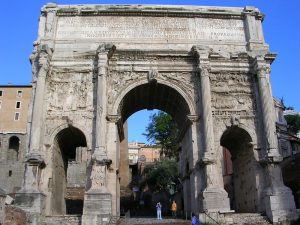The Arch of Septimius Severus, a marble structure in Rome built in 203, was erected to immortalize the victories of Emperor Septimius Severus and his sons, Caracalla and Geta, over the Parthians. The arch has suffered the passage of time, but its facade still has images of the Parthians’ defeat in the years 194-195 and 197-199.
Structure
The arch stands at the northeastern edge of the Roman Forum, a rectangular plaza in ancient Rome home to government buildings. The structure is 23 meters high and 25 meters wide and features three arches resting on piers. The main archway has openings on its sides, leading to the two smaller archways. There used to be an opening on the south pillar that allowed entry to a staircase leading to a chamber in the attic. From there, one can climb up to the top of the arch.
The top of the arch today does not have decorations, but according to coins that were minted during the arch’s time, a statue of Severus used to stand there. The emperor’s statue is featured riding a chariot pulled by six horses, coated in bronze. On either side of the emperor were his sons, Caracalla and Geta, mounted on horses and possibly gilded in silver. Wreaths and other symbols of victory would most likely have adorned the figures on top of the arch.
The interior of the arch, along with its foundations, is made of a type of limestone called travertine. Meanwhile, the whole surface, along with the columns, is made of Proconnesian marble, a type of gray marble.
The inscription on the arch’s attic was coated with bronze and would have glimmered in the noontime sun. It was a memorialization of Severus and his son’s conquests of the Parthians. These victories resulted in Severus’ taking of Ctesiphon, a city in ancient Iran, which led to the founding of a new province of Mesopotamia. However, when Severus died, and Caracalla had his brother, Geta, murdered, a condemnation of memory was declared on Geta, and his name and images on structures and records were erased. Consequently, Geta’s name on the arch was removed, and only Severus’ and Caracalla’s honorifics remain on the inscription:
To the Imperator Caesar Lucius Septimius, son of Marcus, Severus Pius Pertinax Augustus, father of his country, conqueror of the Parthians in Arabia and Assyria, Pontifex Maximus, with Tribunician powers 11 times, triumphing general 11 times, consul 3 times, and proconsul; and to the Imperator Caesar Marcus Aurelius, son of Lucius, Antoninus Augustus Pius Felix , with tribunician powers 6 times, consul, proconsul, father of his country — the best and bravest of princes — on account of the republic restored and the empire of the Roman people increased by their outstanding virtues at home and abroad, the Senate and the Roman people dedicate this arch.
Though many of the depictions have been eroded by the centuries, the image of Mars, the god of war, can still be seen on the keystones. These keystones are found on the central arch on both sides of the structure. The image of Mars is flanked by the goddess of victory, each holding staffs or trophies.
Meanwhile, the keystones on the smaller arches each display the gods Bacchus and Hercules, who were the personal favorites of Severus. Flanking Bacchus and Hercules were river gods. A horizontal display of images, called a frieze, is right above these smaller arches. Here, conquered soldiers are depicted, along with plundered treasures.
The huge attraction of the arch, second only to the inscription, is the four large panels, two on each face of the arch. These panels illustrate spectacles from the war against the Parthians. The left panel facing the Forum depicts the Roman army preparing for battle. It also shows Severus addressing the soldiers and the eventual taking of the city of Nisibis, in Mesopotamia. The right panel displays the Roman army destroying the city of Edessa with siege machines. This particular panel also shows beaten Parthian troops and the beginning of a new military operation.
On the side of the arch fronting the Capitoline Hill, the left panel portrays Seleucia’s fall and more conquered Parthians. The right panel illustrates the Roman forces surrounding the city of Ctesiphon and its eventual downfall. This panel also shows the triumphant army being addressed by Severus.
In Later Centuries
During the Middle Ages, the southern half of the arch was attached to a Christian church while the Cimini family, who erected a tower on top of the arch, owned the other half. In the following centuries, the smaller arches were reduced to being used as trade passages until as late as the 1800s. Interestingly, the carvings of a stonemason who kept a shop there are still visible.
Sadly, deep crevices in the marble have been threatening the arch. Pieces of sculpture have also been crumbling off the monument, possibly caused by inferior workmanship when the arch was built. The opening of a roadway through the main arch in the 4th century did not help the structure’s appearance, either, as impact points of wheeled vehicles can be seen just above the base of the columns.
Overall, though, the Arch of Severus has survived in good condition and has served the purpose of immortalizing imperial vanity.
